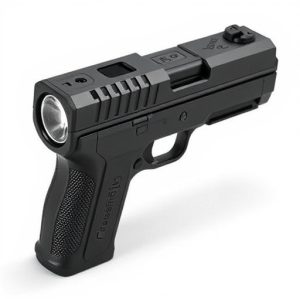Slider Stun Guns: Understanding Electric Current Flow and Safety
A slider stun gun is a personal defense tool that uses high-voltage, low-current electric shocks to…….
A slider stun gun is a personal defense tool that uses high-voltage, low-current electric shocks to paralyze muscles and temporarily incapacitate targets through strategic bursts of bipolar AC. Its unique slider mechanism allows precise control over intensity and duration. Key components include high-voltage batteries, circuit boards, and output terminals, creating a powerful current upon activation. Safety precautions are crucial when using these devices, which require proper training, handling, storage, and awareness of local regulations.
“Unraveling the mysteries of electrical current flow in stun devices, with a focus on the powerful slider stun gun. This article offers an insightful exploration into the fundamental principles that power these self-defense tools. We’ll delve into how slider stun guns utilize electric current to deliver a potent shock, examining the intricate components and circuits involved. Additionally, safety precautions are discussed to ensure responsible usage. Get ready to discover the science behind this innovative personal safety device.”
- Understanding Electrical Current: The Basis of Stun Device Operation
- How Slider Stun Guns Utilize Electric Current Flow
- Components and Circuits Involved in Current Transmission
- Safety Precautions and Considerations for Stun Device Users
Understanding Electrical Current: The Basis of Stun Device Operation
Electrical current is the lifeblood of any stun device, including the popular slider stun gun. Understanding how it flows and functions is crucial to comprehending these powerful personal defense tools. A slider stun gun delivers an electric shock by using a high-voltage, low-current electrical pulse. This pulse disrupts the nerve signals in the body, causing muscle paralysis and temporary incapacitation.
The device’s design ensures that a strong electric field is generated, enabling a small current to flow through the target’s body. The slider mechanism allows for precise control of the intensity and duration of the shock, making it a versatile and effective self-defense tool. This technology leverages the principles of electrostatics and electrical engineering to create a non-lethal but powerful deterrent.
How Slider Stun Guns Utilize Electric Current Flow
Slider stun guns, also known as stun batons or electric shock weapons, are designed to incapacitate an opponent with a powerful electrical current. Their operation hinges on the strategic utilization of electric current flow, delivering a high-voltage pulse in a short burst. The slider mechanism acts as a key component, allowing for precise control over the intensity and duration of the shock. When activated, the stun gun generates a significant electric field, causing the target’s muscles to contract uncontrollably. This sudden and intense contraction leads to temporary paralysis, providing the user with a critical window of opportunity to escape or subdue their assailant.
The current flow in these devices is typically bi-polar, meaning it alternates between positive and negative charges rapidly. This alternating current (AC) delivers a shock that can disrupt the target’s nervous system, interfering with muscle control and sensory perception. The slider mechanism enables users to adjust the settings, allowing for different levels of force while minimizing the risk of permanent harm, which is a critical distinction compared to traditional stun guns that use lower voltage but longer duration shocks.
Components and Circuits Involved in Current Transmission
In a slider stun gun, several key components work together to transmit electrical current and deliver a powerful shock. The primary components include the power source (typically one or more high-voltage batteries), a circuit board that manages current flow, and an output terminal where the current is delivered to the target. The circuit board plays a crucial role in regulating and amplifying the current, ensuring it reaches the desired level for effective stun.
The electrical circuit within the stun gun is designed to rapidly transfer energy from the power source to the output terminal. This involves a combination of resistors, capacitors, and transistors that work together to control the voltage and current levels. When the trigger is activated, the circuit completes a path, allowing the high-voltage current to flow through the output terminal and into the target, causing a strong muscle spasm and temporarily incapacitating them.
Safety Precautions and Considerations for Stun Device Users
When using a slider stun gun or any stun device, safety should always be the top priority. These devices deliver powerful electrical currents capable of incapacitating an attacker for several minutes, but they also come with potential risks. Users must understand that while stun guns are designed to provide self-defense, incorrect usage could lead to accidents or injuries, especially in close quarters. It’s crucial to follow manufacturer guidelines and attend training sessions to learn the proper handling techniques.
Some key safety precautions include ensuring you have a clear path of escape when drawing or using the device, as the electric current can cause muscle contractions that might hinder your ability to move effectively. Always keep the stun gun away from children and pets and store it in a secure location, preferably locked up. Regularly inspect the device for any signs of damage or malfunction before each use. Additionally, be mindful of local laws and regulations regarding stun guns, as possession and usage restrictions vary by region.
Slider stun guns operate through a complex yet fascinating interplay of electrical current flow, leveraging high-voltage pulses to disrupt muscular control and immobilize targets. Understanding the fundamentals of electrical current, as discussed in this article, is crucial for appreciating how these devices function. The components and circuits involved ensure precise transmission of electric current, while safety precautions emphasize responsible use to minimize risks. By knowing how slider stun guns utilize electric current flow, users can maximize their effectiveness while adhering to necessary safety guidelines.


